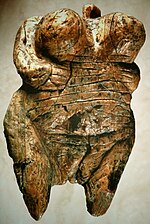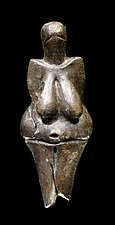Art History/Prehistoric Art
Paleolithic Art[edit | edit source]
Art has been part of human culture for millennia. Our ancestors left behind paintings and sculptures of delicate beauty and expressive strength. The earliest finds date from the Middle Paleolithic period (between 200,000 and 40,000 years ago), although the origins of art may be older still, lost to the impermanence of materials.
Paleolithic Cave Paintings[edit | edit source]

Famous examples of Paleolithic (Old Stone Age) art can be found in France at the caves of Lascaux and Chauvet. Art from this era is also found in regions around the world, including South Africa, where finds at Blombos Cave include an engraved piece of ochre believed to be about 70,000 years old.
In terms of speculating about the consciousness of these artists, it is particularly worth noting that at Lascaux, in what was originally called the Cave of the Dead Man, we could a semiotic effort to talk about the human soul. The "reality" of the representation of all animal figures is very high grade. The one human figure in the cave is done as a stick figure. In the foreground stands a staff surmounted by a bird figure.
Paleolithic Venus Figurines[edit | edit source]

Small figurines dating from the Upper Paleolithic period (from about 40,000 to about 10,000 years ago) have been found throughout Europe. They are referred to as "Venuses", because they usually depict women, often with exaggerated hips and breasts. Some experts believe these figures could be fertility totems and among the first physical representations of a religious or superstitious system. The objects are also sized to be carried easily from place to place as tribes migrated.
The Venus of Willendorf, which was discovered in Austria, is one of the best-known of the Venuses. Carved from limestone, it is estimated to be around 25,000 years old.
Another well-known Paleolithic Venus, "The Black Venus of Dolní Věstonice", was found in the Czech Republic. It is remarkable in that it (together with other objects found nearby) is the earliest known ceramic work of art so far discovered.
-
The Venus of Willendorf from multiple angles.
-
Venus of Hohle Fels
-
Venus of Dolní Věstonice
Mesolithic Art[edit | edit source]

The Mesolithic, or "Middle Stone Age" Period lasted from about 10,000 years ago to the onset of farming in many areas which ranged from about 8,000 - 4,000 years ago. The production of small, portable works of art such as the Venus figurines popular during the Paleolithic era seems to have been greatly reduced.
Rock painting continued into the Mesolithic era, and included highly stylized depictions of human beings. Sites where Mesolithic art has been found include Kamennaya Mogila in the Ukraine, where rather primitive depictions of animals were carved into sandstone, Gobustan in Azerbaizhan and the Zaraut-Kamar grotto in Uzbekistan, both of which include stylized paintings of humans.
American Indian Art[edit | edit source]
-
Great Serpent Mound in Ohio
-
Petroglyph in Utah
-
Petroglyphs in Washington.
-
Nazca lines.
-
Nazca lines.
-
Cueva de las Manos.
Links[edit | edit source]
The Caves of Lascaux
Venus Figures from the Stone Age








